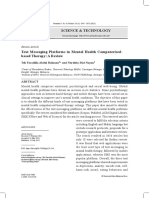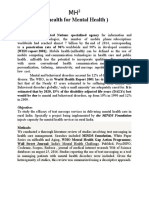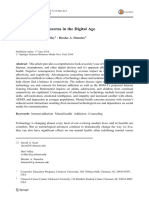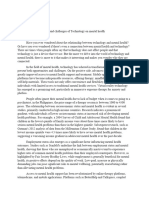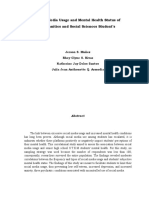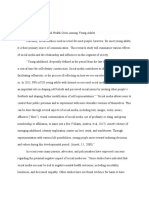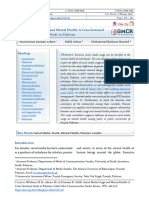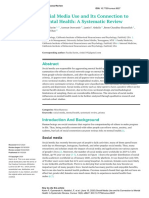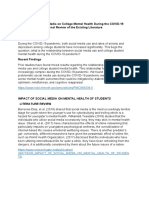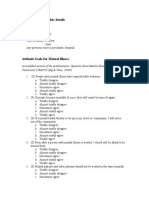Psychiatric Rehabilitation Journal
Manuscript version of
How People With Serious Mental Illness Use Smartphones, Mobile Apps, and Social
Media
John A. Naslund, Kelly A. Aschbrenner, Stephen J. Bartels
Funded by:
• Agency for Health care Research and Quality
• Centers for Disease Control and Prevention, Health Promotion and Disease Prevention Research
• National Institute of Mental Health
© 2016, American Psychological Association. This manuscript is not the copy of record and may not exactly
replicate the final, authoritative version of the article. Please do not copy or cite without authors’ permission.
The final version of record is available via its DOI: https://dx.doi.org/10.1037/prj0000207
This article is intended solely for the personal use of the individual user and is not to be disseminated broadly.
� How People Living with Serious Mental Illness Use Smartphones,
Mobile Apps, and Social Media
Running Title: Technology Use Among People Living with Serious Mental Illness
1
�Abstract
Objective: Research shows that people with serious mental illness are increasingly using mobile
devices. Less is known about how these individuals use their mobile devices or whether they
access social media. We surveyed individuals with serious mental illness to explore their use of
these technologies.
Methods: Individuals with serious mental illness engaged in lifestyle interventions through
community mental health centers completed a survey about their use of mobile and online
technologies. Responses were compared to data from the general population.
Results: Among respondents (n=70), 93% owned cellphones, 78% used text messaging, 50%
owned smartphones, and 71% used social media such as Facebook. Most respondents reported
daily use of text messaging, mobile apps, and social media. Technology use was comparable to
the general population, though smartphone ownership was lower.
Conclusions and Implications for Practice: These findings can inform future interventions that
fully leverage this group’s use of popular digital technologies.
Key words: serious mental illness; community mental health center; social media; technology;
smartphone;
2
�Introduction
Over 3.5 billion people globally use mobile devices, about 3 billion access the Internet, and more
than 2 billion are active social media users (Kemp, 2015). Researchers and clinicians are
developing cutting edge interventions using emerging digital, mobile, and social technologies to
address health disparities including the significantly reduced life expectancy and elevated
chronic disease burden impacting individuals living with serious mental illness (Naslund,
Marsch, McHugo, & Bartels, 2015; Walker, McGee, & Druss, 2015). Prior studies have
documented increasing use of mobile devices among individuals living with serious mental
illness (Firth et al., 2015), however little is known about how these individuals actually use their
own mobile devices or whether they access popular social media such as Facebook.
The success of future technology-based interventions will depend largely on how the target
population of people living with serious mental illness use and access services through their
mobile devices. It is necessary to understand whether and how often these individuals use
features such as text messaging, mobile apps, social media, or connecting with others in order to
inform future interventions that can fully leverage this group’s use of mobile and online
technology. The purpose of this study was to explore how people living with serious mental
illness who receive services through community mental health centers use these technologies.
Methods
Participants were age 21 or older and had a serious mental illness defined by an axis I diagnosis
of schizophrenia, schizoaffective disorder, major depressive disorder, or bipolar disorder (based
on the Structured Clinical Interview for DSM-IV). Participants were excluded if they were
3
�residing in a nursing home or other institution, had cognitive impairment defined as a Mini
Mental Status Exam (Folstein, Folstein, & McHugh, 1975) score <24, had an active substance
use disorder, and were unable to speak English. Participants were recruited from three different
community mental health centers located in urban areas in New Hampshire to participate in
lifestyle intervention studies. The lifestyle interventions focused on promoting healthy eating,
exercise, and weight loss, and were delivered within community mental health settings.
Participants completed a mobile health technology survey as part of their baseline assessment. A
trained research interviewer met with participants in person and administered the surveys in a
community mental health center setting. The mobile health survey consisted of questions about
participants’ use of the Internet, mobile devices, text messaging, and social media, as well as
specific questions about how they use these different mobile and online technologies.
Participants were compensated for completing the assessment. Committees for the Protection of
Human Subjects at Dartmouth College and the New Hampshire Department of Health and
Human Services approved all study procedures.
Data Analysis
Descriptive statistics were calculated for participants’ demographic and clinical characteristics.
Survey responses were tabulated and compared to national data available for the general
population published by the Pew Research Center in 2015 (Anderson, 2015; Duggan, Ellison,
Lampe, Lenhart, & Madden, 2015; Duggan & Page, 2015). This approach of comparing data on
mobile technology use from a community sample of people living with serious mental illness and
from the general population was similarly employed in a recent study (Glick, Druss, Pina, Lally,
4
�& Conde, 2015). Data collection was completed in 2014 and 2015, and data analysis was
completed in 2015.
Results
Participants (N=70) had a mean age of 47.1 years (SD=12.4), and were mostly female (60%) and
predominantly non-Hispanic white (96%). Most participants (81%) lived independently, 17%
lived with family, many were never (46%) or previously (44%) married, 45% had a high school
diploma or less education, and 80% were unemployed. About one quarter (26%) of participants
had a schizophrenia spectrum disorder, 41% had major depressive disorder, and 33% had bipolar
disorder.
Table 1 highlights characteristics of participants’ use of their mobile devices and social media,
including the type of device they use, the frequency of use, and who they contact using these
technologies. The majority (93%) of survey respondents reported owning cellphones, 78% used
text messaging, and 71% used popular social media such as Facebook. Most participants
reported daily use of text messaging, mobile apps or social media. About 30% of participants
with a smartphone or tablet indicated that they had used mobile apps for health or wellness
purposes, and about one quarter of participants who use social media reported posting (24%) or
searching for health related information (26%) on these popular platforms. Participants reported
mainly using text messaging and social media to connect with family or friends.
Figure 1 shows that respondents with serious mental illness engaged in lifestyle interventions
through community mental health centers showed comparable rates of mobile and online
5
�connectivity as the general population. Rates of cellphone ownership, and Internet, text
messaging, and social media use were comparable to the general population. Participants living
with serious mental illness reported lower rates of smartphone ownership (50%) when compared
to the general population (68%).
Discussion
Our findings are consistent with prior surveys and reviews that have demonstrated trends of
increasing mobile device ownership and digital technology use among people living with serious
mental illness recruited through community mental health settings (Ben-Zeev, Davis, Kaiser,
Krzsos, & Drake, 2013; Firth et al., 2015; Glick et al., 2015; Miller, Stewart, Schrimsher,
Peeples, & Buckley, 2015). A recent study of a community sample of people living with serious
mental illness found similarly high rates of text messaging (78%), but lower rates of smartphone
ownership (37%) (Glick et al., 2015). While half of our sample reported owning smartphones,
this was considerably lower than smartphone ownership in the general population (68%)
(Anderson, 2015). Research suggests that this gap in smartphone ownership, which has been
largely attributed to the high costs of these devices, is rapidly closing as the devices and data
plans become more affordable and widely available (Firth et al., 2015).
Importantly, our study expands on prior surveys by exploring how this high-risk group uses
popular social media such as Facebook or Twitter among a middle-age sample of adults with
serious mental illness. One recent survey of inpatients and outpatients with schizophrenia and
mean age of 41 years found that close to half (47%) used social media, of which most (79%)
reported using these websites at least once each week (Miller et al., 2015). We found that a
6
�higher proportion (71%) of our sample used social media, which may be reflective of the fact
that our respondents were community dwelling and did not have impaired cognitive functioning.
We also found that among respondents who reported using social media, they used these
websites frequently (87% reported using these websites weekly) and several reported posting or
searching for health related information. Another recent survey of youth ages 12 to 21 with
serious mental illness recruited from inpatient units and outpatient departments at a New York
hospital found that over 97% were social media users with Facebook as the most popular (94%),
followed by Instagram (61%), Twitter (45%), YouTube (39%), and Tumblr (36%) (Birnbaum,
Rizvi, Correll, & Kane, 2015). Our survey also expands on recent studies that have suggested
that people with serious mental illness are increasingly turning to popular social media to
connect with others, to seek advice, and to share their illness experiences (Highton-Williamson,
Priebe, & Giacco, 2015; Naslund, Grande, Aschbrenner, & Elwyn, 2014). Additionally,
characterizing the use of social media among community samples of people with serious mental
illness is critical in order to inform efforts to leverage these online networks for delivering
interventions aimed at promoting the mental and physical wellbeing of people living with serious
mental illness (Naslund, Aschbrenner, Marsch, & Bartels, 2016).
Limitations
There are several limitations with our study that should be considered when interpreting these
findings. Given the small sample size and lack of racial or ethnic diversity, our findings may not
be representative of the broader population of people with serious mental illness receiving
services through public mental health settings. Further, our respondents were recruited through
community mental health centers located in urban areas from New Hampshire, and therefore the
7
�findings may not generalize to other settings or geographic regions. Lastly, our survey
respondents were enrolled in lifestyle interventions suggesting that they were already interested
in health and wellness. Therefore, our respondents may have been more likely to post or search
for health information on social media or use mobile apps for exercise, diet, or weight loss.
Despite these limitations, our findings offer new insights about how these individuals use their
mobile devices and whether they use social media, text messaging, and mobile apps.
Conclusions and Implications for Practice
This study contributes to a growing body of evidence highlighting the potential of using
smartphone technologies to reach people living with serious mental illness and to support illness
self-management (Ben-Zeev et al., 2014), symptom monitoring (Alvarez-Jimenez et al., 2014),
and health promotion efforts targeting this high-risk group (Aschbrenner, Naslund, Barre, et al.,
2015; Aschbrenner, Naslund, Shevenell, Mueser, & Bartels, 2015; Naslund, Aschbrenner, &
Bartels, 2016). The successful development and dissemination of mobile health interventions
likely will be dependent on whether these interventions can be seamlessly integrated into the
patterns of daily mobile device use among the target group of people with serious mental illness.
For example, mobile health interventions must capitalize on the ways in which people with
serious mental illness use their devices, further highlighting the importance of understanding
how these individuals use mobile and online technologies. Our findings can inform efforts that
take full advantage of the different features of these technologies and could support the design of
tailored interventions to extend the reach and quality of services delivered through community
mental health settings.
8
�Figure 1. Technology
Figure use use
1. Technology among people
among living
people withwith serious
serious mentalmental
illnessillness compared
compared to the to the
a, b
general populationa, b
population
general
a
Values
a
represent proportions of the entire community sample (n=70) of people living with serious mental illness
surveyed.Values represent proportions of the entire community sample (n=70) of people with serious mental illness
b surveyed
National survey data was obtained from the Pew Research Center reports from 2015 on Internet, smartphone, and
b
National survey data was obtained from the Pew Research Center reports from 2015 on Internet,
social media use (Anderson, 2015; Duggan5,6 et al., 2015; Duggan & Page, 2015).
smartphone, and social media use
9
�Table 1. How people living with serious mental illness use mobile devices and social media
Participants
Survey Responses
n (%)
Among the 63 (93%) participants who own a cellphone:
Use a cellphone to access the Internet 25 (40%)
Frequency of sending or receiving text messages
Daily 31 (49%)
Weekly 12 (19%)
Less than once per week 6 (10%)
Use text messaging to contact
Family 38 (60%)
Partner or spouse 10 (16%)
Friend 35 (56%)
Among the 41 (59%) participants who own a smartphone or tablet:
Type of mobile device
Android Smartphone 23 (56%)
iPhone 5 (12%)
Tablet 10 (24%)
Other smartphone 3 (8%)
Use mobile device to access apps 39 (95%)
Frequency of using mobile apps
Daily 30 (73%)
Weekly 6 (15%)
Less than once per week 4 (10%)
Use mobile apps to connect with family and friends 25 (61%)
Amount willing to pay for a mobile app
Will not pay, only download free apps 26 (63%)
Will pay only $0.99 for an app 2 (5%)
Will pay more than $0.99 for an app 12 (29%)
Use of mobile apps for health
Use mobile apps for exercise 12 (29%)
Use mobile apps for diet 14 (34%)
Use mobile apps for weight loss 11 (27%)
Use mobile apps for quitting smoking 1 (2%)
Among the 50 (71%) participants who use social media:
Device used to access social media
Smartphone 24 (48%)
Tablet 16 (32%)
Computer 32 (64%)
Frequency of using social media
Daily 38 (79%)
Weekly 4 (8%)
Less than once per week 6 (13%)
Use social media to connect with
Family 37 (74%)
Partner or spouse 2 (4%)
Friend 42 (84%)
Ever posted personal health information on social media 12 (24%)
Ever searched for health information on social media 13 (26%)
10
�References
Alvarez-Jimenez, M., Alcazar-Corcoles, M., Gonzalez-Blanch, C., Bendall, S., McGorry, P., &
Gleeson, J. (2014). Online, social media and mobile technologies for psychosis treatment:
a systematic review on novel user-led interventions. Schizophrenia research, 156(1), 96-
106.
Anderson, M. (2015). Technology device ownership: 2015. Retrieved from
http://www.pewinternet.org/files/2015/10/PI_2015-10-29_device-ownership_FINAL.pdf
Aschbrenner, K. A., Naslund, J. A., Barre, L. K., Mueser, K. T., Kinney, A., & Bartels, S. J.
(2015). Peer health coaching for overweight and obese individuals with serious mental
illness: intervention development and initial feasibility study. Translational Behavioral
Medicine, 5(3), 277-284.
Aschbrenner, K. A., Naslund, J. A., Shevenell, M., Mueser, K. T., & Bartels, S. J. (2015).
Feasibility of behavioral weight loss treatment enhanced with peer support and mobile
health technology for individuals with serious mental illness. Psychiatric Quarterly, 1-15.
Ben-Zeev, D., Brenner, C. J., Begale, M., Duffecy, J., Mohr, D. C., & Mueser, K. T. (2014).
Feasibility, acceptability, and preliminary efficacy of a smartphone intervention for
schizophrenia. Schizophrenia Bulletin, 40(6), 1244-1253.
Ben-Zeev, D., Davis, K. E., Kaiser, S., Krzsos, I., & Drake, R. E. (2013). Mobile technologies
among people with serious mental illness: opportunities for future services. Adm Policy
Ment Health, 40(4), 340-343.
Birnbaum, M. L., Rizvi, A. F., Correll, C. U., & Kane, J. M. (2015). Role of social media and the
Internet in pathways to care for adolescents and young adults with psychotic disorders
and non‐psychotic mood disorders. Early intervention in psychiatry.
11
�Duggan, M., Ellison, N. B., Lampe, C., Lenhart, A., & Madden, M. (2015). Social media update
2014. Retrieved from
http://www.pewinternet.org/files/2015/01/PI_SocialMediaUpdate20144.pdf
Duggan, M., & Page, D. (2015). Mobile messaging and social media 2015. Retrieved from
http://www.pewinternet.org/files/2015/08/Social-Media-Update-2015-FINAL2.pdf
Firth, J., Cotter, J., Torous, J., Bucci, S., Firth, J. A., & Yung, A. R. (2015). Mobile phone
ownership and endorsement of “mHealth” among people with psychosis: a meta-analysis
of cross-sectional studies. Schizophrenia Bulletin, sbv132.
Folstein, M. F., Folstein, S. E., & McHugh, P. R. (1975). Mini-mental state: A practical method
for grading the cognitive state of patients for the clinician. Journal of Psychiatric
Research, 12(3), 189-198.
Glick, G., Druss, B., Pina, J., Lally, C., & Conde, M. (2015). Use of mobile technology in a
community mental health setting. Journal of telemedicine and telecare,
1357633X15613236.
Highton-Williamson, E., Priebe, S., & Giacco, D. (2015). Online social networking in people
with psychosis: A systematic review. International Journal of Social Psychiatry, 61(1),
92-101.
Kemp, S. (2015). Digital, social and mobile worldwide in 2015. Retrieved from
http://wearesocial.com/uk/special-reports/digital-social-mobile-worldwide-2015
Miller, B. J., Stewart, A., Schrimsher, J., Peeples, D., & Buckley, P. F. (2015). How connected
are people with schizophrenia? Cell phone, computer, email, and social media use.
Psychiatry Research, 225(3), 458-463.
12
�Naslund, J. A., Aschbrenner, K. A., & Bartels, S. J. (2016). Wearable devices and smartphones
for activity tracking among people with serious mental illness. Mental Health and
Physical Activity, 10, 10-17.
Naslund, J. A., Aschbrenner, K. A., Marsch, L. A., & Bartels, S. J. (2016). The future of mental
health care: peer-to-peer support and social media. Epidemiology and psychiatric
sciences, 25(2), 113-122.
Naslund, J. A., Grande, S. W., Aschbrenner, K. A., & Elwyn, G. (2014). Naturally occurring
peer support through social media: the experiences of individuals with severe mental
illness using YouTube. PLOS ONE, e110171.
Naslund, J. A., Marsch, L. A., McHugo, G. J., & Bartels, S. J. (2015). Emerging mHealth and
eHealth interventions for serious mental illness: a review of the literature. Journal of
Mental Health, 24(5), 321-332.
Walker, E. R., McGee, R. E., & Druss, B. G. (2015). Mortality in mental disorders and global
disease burden implications: a systematic review and meta-analysis. JAMA psychiatry,
72(4), 334-341.
13







